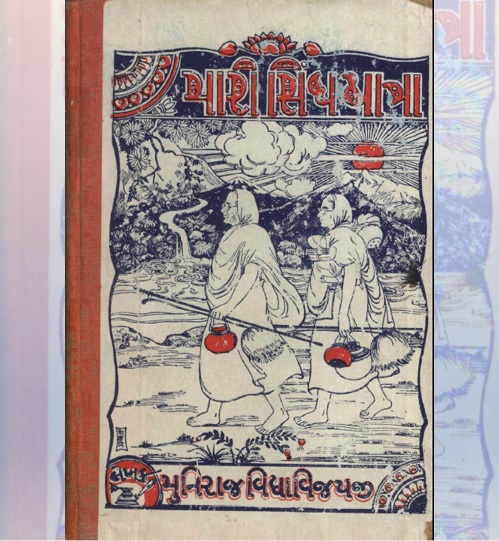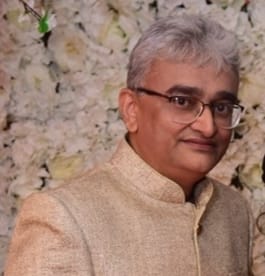
There are many communities within Sindhi Hindus. Sindhi, Punjabi, Pushkarna Brahman, Saraswat Brahman, Lohana, Nasarpuri, Shikarpuri, Bhaiband, Hyderabadi, Aamil, etc.
[Editor’s Note: This is Part 20 (Sindhi Hindus – Part 1) of a series of articles based on a pre-partition book named “મારી સિંધ યાત્રા” (“منهنجي سنڌ جو سفر”) in Gujarati authored by a scholarly Jain sadhu Shri Vidyavijayji, narrating his experiences of Journey and his Stay in Karachi for about 2 and a half years between 1937 and 1939. It would be advisable to click on the Introductory Article and read it to better understand the series. – Nasir Aijaz, Editor Sindh Courier]
Vimal Shah, Mumbai
[There’s a large chapter running into several pages describing the culture of ‘Sindhi Hindus’. Translation of this chapter itself would be like a mini-series of articles running into multiple parts. I am sure Sindhis worldwide would be amused by the level of detailing done by a Jain Sadhu – Vimal Shah]
Sindhi Hindus
Wherever I have written about the Sindhi Hindus in the previous chapter, it is all in the form of a brief introduction. Since there are a lot many things that remain to be described about Sindhi Hindus this independent chapter is dedicated to them. We have already seen in the first chapter that Hindus from different regions came and settled in Sindh during different periods. While many of them converted to Islam, some of them remained Hindu for one or other reasons. Apart from them, many other Hindus who migrated subsequently from Multan, Jaisalmer, etc. are known as Sindhi Hindus today. It is already said that the population of Hindus is 23 per cent in Sindh. Whereas the population of Muslims is 75 per cent in Sindh and 2 per cent of Christians, Parsi, and other communities.
Various Communities of Sindhi Hindus
There are many communities within Sindhi Hindus. Sindhi, Punjabi, Pushkarna Brahman, Saraswat Brahman, Lohana, Nasarpuri, Shikarpuri, Bhaiband, Hyderabadi, Aamil, etc. Among these, the people known as Vaniya include primarily Hyderabadi and Shikarpuri, or Aamil and Bhaiband. These two communities are most popular.
It is said that the Shikarpuris were the first ones to venture into business. Today Shikarpuris trade with large cities and even foreign countries
Despite sharing similar food habits and certain customs, these Sindhis have divided themselves into two different communities. Not only that, but we also find instances of one brother in a family known as Aamil and the other as Bhaiband. Slowly they started differentiating their customs and inculcated feeling of upper and lower caste. Aamils consider themselves upper caste as compared to Bhaiband. It is said that Aamils marry daughters of Bhaihand but generally do not marry their daughters to them. But these days some people have started marrying on either side.”
Aamil
Out of both the communities, Aamils are better placed, educated, and leading one. Why are they known as Aamils? Not much of details of its origin are available. What we know by enquiring with many people, particularly historians are – During the period of Mirs, those who had ‘Amal’ i.e., Powers in their hands became to be known as ‘Aamils’ and the rest of them as ‘Bhaibands’. Aamils are also known as ‘Diwan’ today because they used to hold higher positions like Diwan during the period of Mirs. Their descendants are the ones known as Diwan today. During the period of their powerful positions, they were beneficiaries of big Jagirs and lands from the Badshahs. Many Aamils are the Zamindars of those lands even today. And therefore, many of them are among popular Zamindars today. There are many Aamils who own thousands of Bigha land even today and they earn attractive agricultural income.
The Aamils are mostly employed. They hold positions like Commissioners, Collectors even today. Now they get fewer opportunities because of the political powers of Muslims in Sindh.
Surnames
These people have surnames like Gidwani, Adwani, Wazirani, Gulrajani, Punrajani, Mirchandani, Jhangiani, etc. These surnames are derived from their ancestors bearing those names. Gidwani is derived from Diwan Gidumal. It is said that Gidumal had come from Multan. The name of Gidu Bandar near Hyderabad was based on his name. Along with Gidumal, one Aadumal had also come, his descendants are known as Adwani. There is a lane named Adwani in Hyderabad. Two more adjoining lanes are named Gulrajani and Punrajani. Gulraj and Punraj were two Hindu Sonis (Goldsmiths). And it is said that they came from Balochistan.
The Bhaibands being in business are more generous people. They too are like Aamils in observing most of the customs
From the chapter on ‘Malani’ the readers already know that the region was named after ‘Malaji’. The grammar rule of suffixing ‘ani’ to the names is used in that region (Rajasthan), the same thing is seen here as well. The descendants of ‘Gidu’ are ‘Gidwani’, the descendants of ‘Aadu’ are ‘Adwani’, Lane of ‘Gulraj’ is ‘Gulrajani’, and Lane of ‘Punraj’ is ‘Punrajani’. In ancient times many parts of Rajputana (Marwad), Bahawalpur, Afghanistan, Punjab, etc. were a part of Sindh. That’s why it seems this practice of suffixing ‘ani’ was prevailing everywhere in those times.
Bhaiband
Everyone other than Aamils became to be known as ‘Bhaiband’. Those who ventured into business were all ‘Bhaiband’, despite being brothers of the same family. All those in business were their brothers or relatives, so they too became to be known as ‘Bhaiband’. It is said that the Shikarpuris were the first ones to venture into business. Today Shikarpuris trade with large cities and even foreign countries. Nowadays Nasarpuris and many others are into business.
The Bhaibands being in business are more generous people. They too are like Aamils in observing most of the customs.
Food Habits
Food of both the communities consists of fish, meat, wine, and eggs. Generally, Roti and Bhaji are their traditional food. Affluent people consume more fish and meat. They can’t live without wine. Hindus consume more fish and meat compared to Sindhi Muslims because Sindhi Hindus are wealthy. Poor Muslims can’t afford a lot of fish and meat. If Sindhis must taunt someone, they will say:
Jē kadahī tu vaḍō māṇūṁ āhīṁ,
Tō tuṁ bhalē gōshta macchī śharāba bē pī’uṁ,
Para māṁ garība dāla-mānī khā’ī gujara kandūsa
جيڪڏھن تون سردار آهين،,
تہ ڀلي گوشت مڇي کاءُ ۽ شراب پيءُ
پر مان غريب دال ماني کائي گذر ڪندس
That means:
If you are wealthy,
Then you eat Meat-Fish and drink wine every day,
But we are poor so we will survive on dal-roti.
Amils use the term ‘Mani’ and Bhaibands use ‘Rotli’ or ‘Phulka’ for roti. Amils use the term ‘Gosht’ and Bhaibands use ‘Mans’ for meat. Generally, the Bhaibands use less of terminologies used by Muslims.
[Vimal Shah: It would be interesting to know that Gujaratis as well use the term ‘Rotli’ and ‘Phulka’ for roti and ‘Mans’ for meat. ‘Phulka’ is a commonly used term across India.]
Both communities have a tradition of eating a lot of ‘Papads’. They would certainly offer Papad to guests while savories like sweets may or may not be available at home. They would never serve water alone. Those living with large families or have many visitors have a large consumption of Papads. An elderly lady from a Bhaiband family told me that we roast nearly 100 to 125 Papads every day. Papads are consumed by every household to an extent.
They do not mind employing people from any community for their kitchen work. All the daily chores are done by Muslims as well
If you visit any Sindhi house, you will find people sitting on Charpoys (traditional cots) and eating Bhaji-Mani. While fashionable people use a table and chair for dining. They do not mind employing people from any community for their kitchen work. All the daily chores are done by Muslims as well.
The elderly mothers do not like all these. Elderly people do not like the fashions of girls, and the free entry of lower caste sweepers and Muslims in the house. But who cares for elderly people today? (Continues – read Part-XXI on Sunday July 16, 2023)
Click here for Part-I, Part-II, Part-III, Part-IV, Part-V , Part-VI , Part-VII , Part-VIII , Part-IX, Part-X, Part-XI, Part-XII, Part-XIII , Part-XIV, Part-XV, Part-XVI , Part-XVII, Part-XVIII , Part-XIX
_____________
About the contributor of the series of Articles based on the book
 Vimal Shah is a follower of Jainism by birth and is based in Mumbai, India. He is a Computer Engineer and holds a Diploma in Jainology from Mumbai University. He has an immense interest in reading, writing, studying, and teaching Jain Philosophical subjects. He conducts classroom as well as online sessions on Jain Philosophical courses. He continues to study various subjects and remains a student of Jain Philosophy. He has significantly contributed to the Translation Project of the ‘Compendium of Jainism’ from English to Gujarati – an initiative of the JAINA India Foundation. He is also associated with a Project for the translation of Jain Aagams (Scriptures) from Gujarati to English. He has a special interest in the history and preservation of the Jain Heritage in Pakistan. He was part of a Delegation of the Jain Heritage Foundation, New Delhi that visited various Jain Heritage Sites in Pakistan in May-2023.
Vimal Shah is a follower of Jainism by birth and is based in Mumbai, India. He is a Computer Engineer and holds a Diploma in Jainology from Mumbai University. He has an immense interest in reading, writing, studying, and teaching Jain Philosophical subjects. He conducts classroom as well as online sessions on Jain Philosophical courses. He continues to study various subjects and remains a student of Jain Philosophy. He has significantly contributed to the Translation Project of the ‘Compendium of Jainism’ from English to Gujarati – an initiative of the JAINA India Foundation. He is also associated with a Project for the translation of Jain Aagams (Scriptures) from Gujarati to English. He has a special interest in the history and preservation of the Jain Heritage in Pakistan. He was part of a Delegation of the Jain Heritage Foundation, New Delhi that visited various Jain Heritage Sites in Pakistan in May-2023.